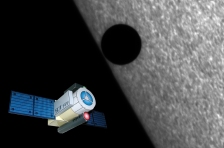The Smallest Planet To Date (2007/04/28)
Using its most precise spectrograph, HARPS, installed in La Sillia, Chile an ESO team of European astronomers announced discovery of an exoplanet which to date resembles Earth closest. It is the third planet discovered around the red dwarf star Gliese 581, a faint 20.4 light-years remote 10.6 magnitude star in the constellation of Libra, no larger than 0.38 sun radii, weighing a mere 0.31 sun masses.
The planet, designated Gliese 581c, orbits the star in a distance of 0.073AU (14 times closer than our Earth is to its sun) with a period of 12.932 days. In spite of its
close proximity, the planet is well situated within the habitable zone of the star which is smaller, colder and far less intrinsically luminous than our sun.
The planet's surface temperature is estimated to span over 0 and 40°C (30 to 100°F), a window within which water exists in liquid form. Gliese 581c is 50% larger than Earth in diameter and could be rocky as well as be covered with an ocean. In its close orbit 10 times as eccentric as Earth's, Gliese 581c may be subjected to strong seasonal variations and tidal forces, while the planet may be tidally locked, with one hemisphere always lit and the other always dark.
The 3 known planets are:
| Planet | Mass (E) | Period | Distance |
| Gliese 581b | 15.6 | 5.37d | 0.041AU |
| Gliese 581c | 5.06 | 12.93d | 0.073AU |
| Gliese 581d | 8.3 | 83.6d | 0.243AU |
|
|

Gliese 581c with another, but Neptune-like planet (artist's impression).
Credit: ESO (PR Photo 22a/07)

The star Gliese 581 centered in a 6 arcminute wide section of the sky.
Credit: Digitized Sky Survey
|
Another system known to have three low mass planets is HD 69830 also discovered by HARPS
which is capable of detecting velocity variations between 2 and 3 meters per second, corresponding to about 9 km/h,
in other words, near walking speed! Gliese 581c is a milestone. We may look forward to further discoveries of Earth-like planets and
eventually find a sister world, hopefully not too far away. 20 light-years is astronomical neighborhood, however,
mankind cannot (yet) travel over such huge distances (probably fortunate for possibly existing nature).
 |
|



















